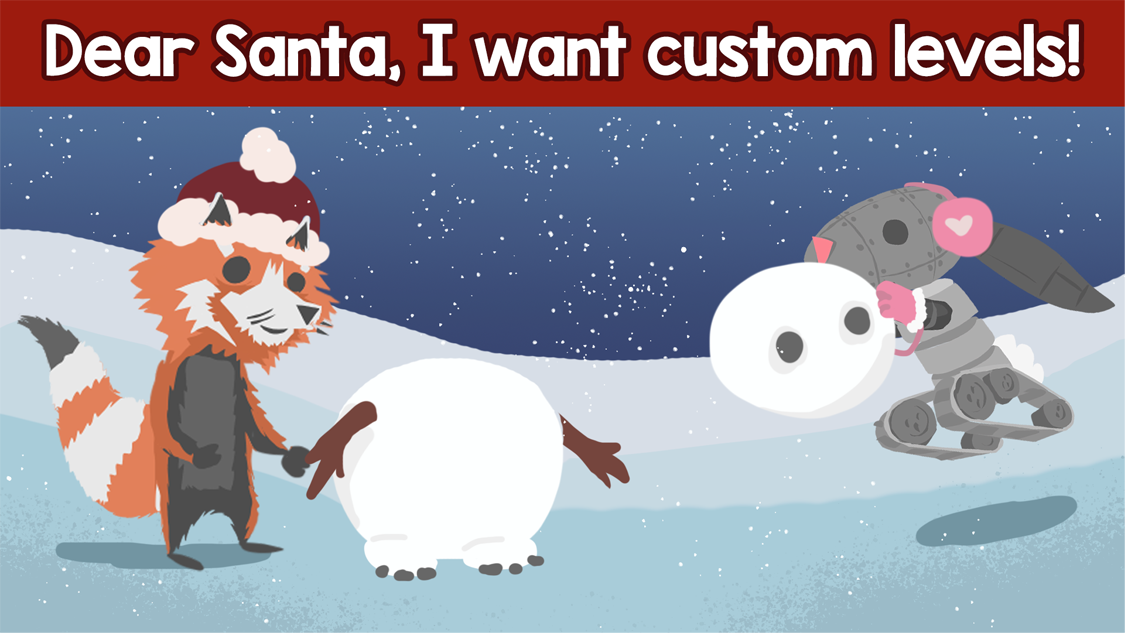Behind the scenes: The beehive
/This is the final article in a 7-part series written by Eve, the Clever Endeavour Community Manager, about the making of the A-cobra-tic Update for Ultimate Chicken Horse, which was released in March 2020. Each article reveals some of the process of making new content for the game, and shows in-progress images of each of the A-cobra-tic features that have never been shown to the public before.
Not the bees!
The beehive as a new block for the A-cobra-tic Update kind of snuck up on us.
At our first meeting about the update, we all agreed to make 3 blocks, and the favored ideas were unanimous. Though their design changed with iteration, we knew we were setting out to make a set of blocks with certain features, and those became the flamethrower, cannon, and one-way gate.
At our second meeting, we mostly discussed the design of those blocks, but Alex also pitched this new idea of a beehive and bees chasing players. As he put it, the concept was basically to introduce the Move or Die mechanic to Ultimate Chicken Horse, by adding something that would create a momentary pressure to keep moving forward no matter what, without any chance to pause and think.
this game also has a chicken in it!
The team was immediately enthusiastic about the idea of murderous bees. Who wouldn’t be? Therefore, we left the meeting knowing that we would prototype four blocks for the update, rather than three, as we initially intended. (This is what is known as scope creep, by the way.)
Art-wise, there were few iterations from the original placeholder image to the final design of the beehive:
placeholder
first concept art
final art
Small tangent to avoid the ire of bee enthusiasts and to educate those who aren’t apiculturally inclined: this kind of artistic representation, which everyone thinks of as a beehive, is in fact more akin to a bee skep. Natural beehives only look like semi-amorphous blobs of honeycombs, usually covered in buzzing bees. Bee skeps are bell-shaped straw baskets that people used for beekeeping before square apiary boxes became the norm, and though they are rarely used nowadays, their appearance has shaped people’s collective imaginary for beehives in a pretty permanent manner.
a beehive, without the usual swarm of bees
ye olde bee skep
Moving on to the bees themselves, the first “programmer art” version of them was simply a cloud of flies, taken from the Zombie Modifier animation, duplicated and rotated to look like a swarm. While we usually hand animate pretty much everything in Ultimate Chicken Horse, this placeholder helped us see that a different solution involving procedurally animated bee particles would be preferable, so that’s what Kyler set out to do. It’s hard to illustrate the details of that process, but it involved coming up with semi-random movement algorithms to create a visual effect that’s reminiscent of the organized chaos of bug swarms.
At the same time as artists were refining the bees’ look throughout development, programmers ran into a number of bugs (hehehe) to iron out with things like pathing, as shown below.
typical #gamedev stuff
On top of artistic considerations and programming issues, we also kept facing new design questions to answer about the desired bee-haviour (sorry). For example: Should Ghosts be able to activate them? (We decided that they should, on account of the fact that it would be hilariously chaotic to allow players to torture each other from beyond the grave that way.)
One design question we pondered for a long time was whether bees should return to their hive after a kill, making the beehive possible to activate once more by a new victim. We experimented a bit with this, and saw two problems. First, we felt it was difficult to visually communicate the difference between hazardous bees targeting a player, and inoffensive bees making their way back home. When bees dispersed back to their origin, they definitely looked like they were a danger, yet we didn’t want them to be. Second, it wasn’t fully evident when was the exact moment that all bees had returned to their hive, and the beehive could be activated again.
bees returning to their hive after a kill
Aside from those concerns, we also realized that it could actually be more interesting for beehives to be activated only once. If a beehive is placed where all players have to pass to reach the goal, they make it riskier to try and get First points. Similarly, bees can guard a coin, and selectively force players who get greedy to be on their toes. These kinds of things can help even out the playing field, by making that one platformer deity in your friend group face greater challenge in their quest to score a victory. For all these reasons, we ultimately decided to make bees fade away after successfully killing their target.
RIP
Like always, the final piece of the puzzle for this block was to have Vibe Avenue make the sound effects to go with it. There is nothing like the noisy buzzing of a swarm of bees chasing you to instill a real sense of urgency!
In addition to the sounds you hear during gameplay, every single block in Ultimate Chicken Horse also needs a number of audio effects in the user interface: for example, when you hover over it before selecting it in the Party Box or Inventory. These often aren’t noticed so much, but they can go a long way to make the game feel more responsive and alive. The beehive placement sound effect has become my favorite example of that. The fact that you hear a tiny “bzzbzz!” every time you place down a beehive simply makes me want to use that block more!
Of all the blocks in the A-cobra-tic Update, the beehive came with the biggest design challenges and demanded the most work. In the end though, we regret nothing about somewhat spontaneously deciding to add it to Ultimate Chicken Horse. We think it’s one of the most interesting blocks in the game yet, and our players’ positive reaction to it easily justifies our perseverance.
Thank you for reading this behind-the-scenes series! If you missed any of them, please also check out the articles on the flamethrower, Snake, the cannon, Space, the one-way gate, and The Ballroom.



















